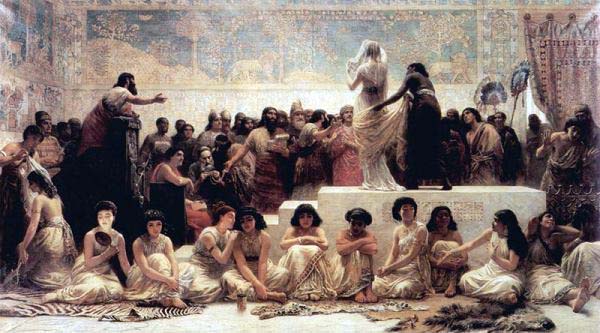
"The Babylonian Marriage Market", 1875. Edwin Long (1829-1891)
The Babylonians were energetic, active, and full of adventure. Everywhere, by sea as well as by land, they endeavored to make themselves acquainted with the world, and became the most distinguished merchants of the age. Everything that could be bought and sold was to be had in the emporiums of their great metropolis. Trade and commercial activity was the life of the Capital.
Under these conditions the Babylonians became avaricious to an overwhelming degree. Whatever would bring money was for sale. Even domestic virtues were flung recklessly away for financial gratification. Every woman must once in her life appear in public before the temple of Beltis, as by this means crowds of strangers were drawn to the city. And on regular occasions maidens were brought in large numbers and sold at auction in order that the wealthy princes and libertines of surrounding nations might be drawn to their unscrupulous market. Fathers and brothers with their daughters and sisters stood ready to barter for money the pleasures due only to love. Everything that ministered to the craze for adornment, appetite, and sensualism was supplied and indulged to the highest degree possible. The palace halls were nothing less than harems of polygamy.
The picture presented is full of traditional and legendary story as well as historical fact, and illustrates the manner in which Babylonian maidens were disposed of in marriage. The grouping of the figures yields an effect which could not be improved upon, and which was never surpassed by the artist himself It may be called Edwin Long's most noted production, next to his ''Diana or Christ,'' shown elsewhere in this collection. At the Hermon sale, in 1875, the "Marriage Market" brought $33,000.
The artist studied under Phillip, in London, and later visited Spain, Egypt and Syria, becoming a member of the Royal Academy in 1876. His "Assyrian Captive," "Egyptian Feast," "Ancient Custom," etc., are all works of merit, though not equal to the two shown in this collection.
(This text is a digital copy of a book, "Franklin Edson Belden:Historic Men and Scenes". This book, published in 1898, is already in the public domain.)